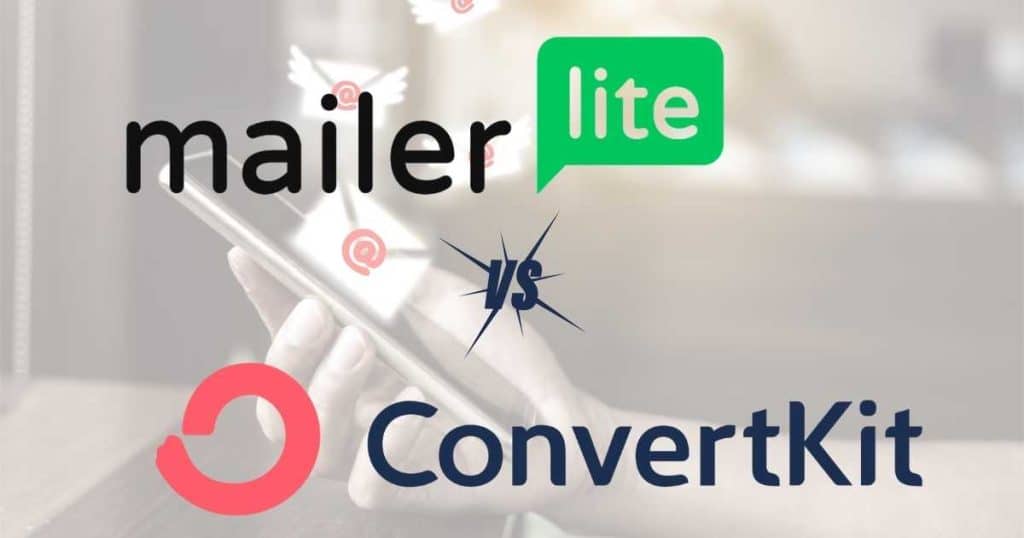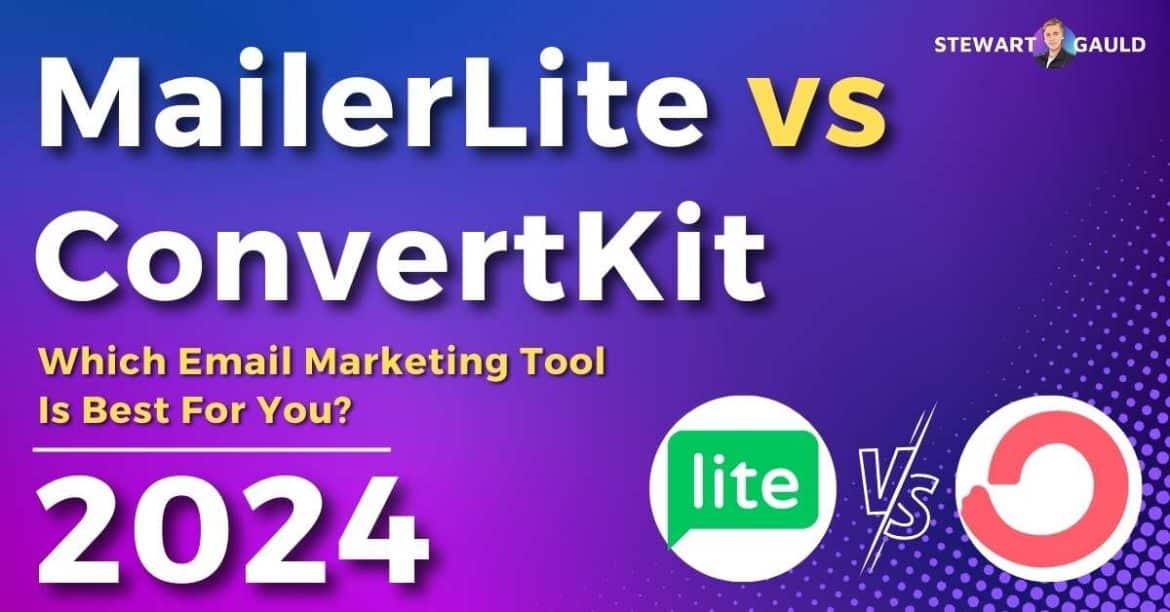In this MailerLite vs ConvertKit comparison guide, you’ll learn everything there is to know about both tools to help you decide the best choice for you.
Are you feeling lost in the sea of email marketing tools, unsure which one will truly elevate your email campaigns?
I get it – I’ve been there.
But the good news is that if you’re tossing between MailerLite and ConvertKit, you’re on the right track!
Both tools can take your email marketing game to new heights. But which is best for you?
Read more: Top 5 Best FREE Email Marketing Software For Small Business.
Quick Summary
- MailerLite is best for small teams or beginners on a budget because of its impressive yet affordable pricing plans and easy-to-use (yet powerful) email marketing features.
- ConvertKit is the obvious choice for creatives who want to grow and monetize their audience through simple text-based personalized campaigns.
- MailerLite is better for customization and email templates, but ConvertKit outshines when it comes to automation and segmentation.
- Both platforms have a free plan.
MailerLite vs ConvertKit 2024

Among the many email marketing services available, MailerLite and ConvertKit are at the top of the game, both offering appealing and feature-rich packages.
But the question that arises is, which one is the ideal choice for you?
Well, I’m here to provide you with all the answers in this comprehensive and straightforward, side-by-side MailerLite vs ConvertKit comparison.
So, buckle up and get ready to catapult your email marketing efforts to new horizons!
Read more: 5 MailerLite Alternatives.
What Are They? MailerLite vs ConvertKit
Born in 2010, MailerLite continues to reign supreme as one of the most popular email marketing tools on the market.
The easy-to-use interface, affordable pricing plans, and integrated blog and website builder are just some of the reasons why so many still rave about MailerLite (all these years later!)
And with segmentation, A/B testing, and automation capabilities, MailerLite simplifies even the most complex functions, ensuring that even beginners can create captivating emails.
In contrast, ConvertKit was created in 2013 as a stylish and minimalist option in the realm of email marketing and automation.
Tailor-made for content creators and small business creatives, ConvertKit helps you forge personal connections with your audience and grow and monetize your brand.
Whether through landing pages, sign-up forms, email segmentation, or automations, their aim is to replicate the experience of receiving an email from a close friend.
Read more: How To Use ConvertKit.
What Are The Differences Between MailerLite vs ConvertKit?

While MailerLite and ConvertKit both allow you to send targeted emails, there are some distinctions you should know about before diving head-first into either tool.
MailerLite is an affordable option for small to medium-sized businesses, offering a straightforward interface, advanced features, and a wide range of email templates.
ConvertKit, on the other hand, targets creators and entrepreneurs, emphasizing personal connections through a minimalist design.
In other words, MailerLite caters to various business needs, whereas ConvertKit focuses on audience management and segmentation for creatives.
There are also differences regarding their target audience, interface and features, email design templates, and pricing.
So, with that said, let’s take a closer look at these now!
Read more: MailChimp vs MailerLite.
Ease Of Use
If your priority is ease of use, you won’t be disappointed with either MailerLite or ConvertKit.
That’s right – both excel in providing user-friendly interfaces for email marketing beginners!
MailerLite offers a clean and modern dashboard layout, with intuitive prompts and visual guides to assist with setting up campaigns.
Their user interface and easy-to-use drag-and-drop editor does a great job of simplifying the process of email execution – without overwhelming users!
On the other hand, ConvertKit also offers a clean dashboard layout with step-by-step sequences to guide users through the email creation process.
Plus, their thoughtful touches like ‘hover tooltips’ enhance the user experience (a feature I particularly love!)
Its email editor differs from the typical drag-and-drop style and may take longer to get used to. However, I assure you that it’s just as easy to use!
Winner = Draw.
Read more: MailerLite Integrations.
Pricing
Both MailerLite and ConvertKit’s pricing plans depend on the number of subscribers (contacts) you have.
Because small businesses typically have 500 subscribers or less, I’ll look at pricing plans for 500 (or fewer) subscribers.
MailerLite:
- Free: $0 (up to 1000 subscribers)
- Growing Business: $10 per month.
- Advanced: $20 per month.
- Enterprise: Custom Price.
ConvertKit:
- Free: $0 per month (up to 1000 subscribers)
- Creator: $15 per month (up to 300 subscribers) and $29 per month (300-1000 subscribers)
- Creator Pro: $29 per month (up to 300 subscribers) and $59 per month (300-1000 subscribers).
Winner = MailerLite.
Read more: ClickFunnels vs ConvertKit.
Templates and Email Editor
When it comes to email design and customization, MailerLite and ConvertKit have quite different approaches – so let’s take a look.
As I mentioned, MailerLite’s traditional drag-and-drop type interface and rich-text editor means anyone can effortlessly create customized emails tailored to their brand.
Simply drag and drop pre-built video, social media, and dynamic content blocks and add headers, subject lines, and name fields to create email campaigns with a personal flare.
MailerLite offers over 50 pre-made templates that span a wide range of categories that can be used as a base for your emails.
Unfortunately, these templates are only available on paid plans.
Additionally, if you’re comfortable dabbling in a wee bit of code, MailerLite’s customizable HTML markup allows for more personalization.
On the other hand, ConvertKit provides a clutter-free editing experience with basic inline styling options.
Although there is no ‘drag-and-drop’ editor as such, the editing experience is still easy to grasp!
All you need to do is click the ‘plus’ button to add text or content to your emails – it’s as simple as that.
They also offer blocks for adding elements to your email content, such as:
● Images.
● Files.
● Quotes.
● Links.
● Videos, and more.
And like MailerLite, ConvertKit also allows the editing of HTML code for customization.
In terms of email templates, you’ll only find around 20 with ConvertKit. However, they’re all beautifully designed (and most are available for free, which is a bonus)
ConvertKit’s email design capabilities are certainly more limited than MailerLite’s, but that’s the point!
Minimalist text emails are all part of ConvertKit’s strategy. And their email deliverability rate of 99.73% shows that it works!
Winner = MailerLite.
Read more: Top 5 ConstantContact Alternatives.
MailerLite vs ConvertKit Key Features

Segmentation
Segmentation is a crucial aspect of email marketing that allows for targeted, relevant campaigns.
So, how do MailerLite and ConvertKit stack up?
While MailerLite has a tagging feature called ‘interest groups,’ assigning tags to subscribers can feel over-engineered compared to ConvertKit’s seamless ‘if this, then that’ rule.
With MailerLite, you must use the visual editor to build a dedicated automation (instead of just quickly setting up segments based on each email campaign).
On the other hand, ConvertKit uses tags instead of traditional email contact lists, which provides more flexibility and quicker segment creation.
Rules can be easily set up to automatically assign tags based on subscriber behavior, for example, when someone opens a particular email type.
This allows for hyper-targeted campaigns!
Additionally, ConvertKit’s filter system makes it easy to locate specific contacts once you’ve assigned tags to them.
You can filter your contact search through:
● Tags.
● Custom form fields.
● Location.
● Prior purchases.
● Gender, and more.
It’s not all downhill for MailerLite, though.
You can still segment your audience based on signup source, email engagement, inactivity, and how often they open rates.
However, the platform is generally less flexible than ConvertKit (and requires more effort for segment creation).
Winner = ConvertKit.
Read more: MailerLite vs ActiveCampaign.
Automation
Both MailerLite and ConvertKit offer user-friendly workflow editors to create compelling emails.
Although basic, MailerLite’s drag-and-drop automation interface allows you to set triggers to initiate workflows.
These triggers could be anything from when a subscriber fills in a form, a specific date (maybe a birthday or anniversary), or a subscriber making a purchase.
After setting the trigger, you’ll need to choose a step to follow through using an automation building block. There are five steps you can choose to take:
Email.
- Delay.
- Condition.
- Action.
- A/B split testing.
You can also move someone to another group, remove them from a group, mark them as unsubscribed, progress them to another step in the workflow, and more.
While MailerLite’s workflow builder is relatively simple, it only really covers the basics, and some may find it limiting if you want to create more advanced workflows.
ConvertKit’s strength is that you can create and send automated emails without leaving the workflow designer.
This standout feature provides a seamless experience for quickly developing campaigns!
Like MailerLite, ConvertKit’s automation tools are user-friendly, with workflows based on events (triggers that initiate a workflow) actions, and conditions, which are as follows:
● Events: These could include when a subscriber completes a form, makes a purchase, a specific date, and more.
● Actions: Include sending an email blast, adding or removing tags, moving subscribers to different segments, and delaying actions.
● Conditions: Branching out campaigns into different paths based on specific criteria, such as tags, interaction level, form fill-outs, and others.
While MailerLite and ConvertKit offer powerful email automation features, ConvertKit stands out as the more robust option as it’s easier to create powerful automations quickly.
However, it’s worth mentioning that you can’t build any automations on the free ConvertKit plan, whereas all MailerLite users can use the Email automation builder.
Winner = ConvertKit.
Read more: How To Use MailChimp?
Landing Pages
Both tools come with easy-to-use landing page builders. But which comes out on top?
MailerLite’s 14 customizable landing page templates are categorized into:
● Blog promotions.
● Webinars.
● Featured service.
● Coming soon, and more.
The landing page builder is slightly clunky, but it is possible to create your own designs from scratch using their drag-and-drop builder.
Although, keep in mind that customization options are limited!
Once you’re in, you can access dynamic content blocks such as subscription forms, marketing videos, countdown timers (unique to MailerLite), testimonials, and more.
And with MailerLite’s Stripe integration, you can sell digital products and subscriptions directly from your landing pages!
On the other hand, ConvertKit provides 50+ customizable landing page templates with a slightly larger range of categories.
These include:
● Coming soon.
● Sales.
● Course sign-ups.
● Book releases.
● Lead magnets and more.
ConvertKit has an easy-to-use color picker so you can pick the perfect shade for your fonts and backgrounds, and it integrates seamlessly with Unsplash, a popular stock image library.
Additionally, ConvertKit’s landing page builder allows for more in-depth customization through CSS if you know your way around a bit of code.
Winner = ConvertKit.
Read more: How To Create Automations in MailChimp.
Customer Support

Which email marketing tool will give you a helping hand when you’re stuck?
With MailerLite’s free plan, you can access around-the-clock email support and a handy online knowledge base filled with tutorials, best practices, and webinars.
Plus, upgrading to a paid plan unlocks 24/7 live chat (and the ability to hire experts for specific issues!)
And MailerLite’s Academy also currently (February 2024) offers over 70 free lessons on fundamental MailerLite features.
On the other hand, ConvertKit provides customer support through a ticketing system (business hours only), with priority support available on their Creator plan.
They also have an online knowledge base, blog articles, video training, and a dedicated Creator Community Forum.
In terms of support, MailerLite offers more free online courses and resources, while ConvertKit’s limited support hours are unfortunately a bit of a drawback.
Winner = MailerLite.
Read more: ActiveCampaign Review.
MailerLite vs ConvertKit Who Are They Best For?

Okay, so with everything said and done, which is the best choice for you?
In my opinion, the answer is quite clear!
If you run an information-based, eCommerce, or service based small business, MailerLite is the ideal choice.
Plus, MailerLite is the more affordable option, meaning budget-conscious teams can still send captivating email newsletters and lead-generation campaigns
But for content creators, bloggers, authors, course creators, or other creatives, ConvertKit is the way to go.
With exclusive monetization features through their dynamic Creator Network program, ConvertKit is the perfect email marketing tool that can help grow and scale your brand!
ConvertKit empowers you to simplify and enhance workflows through personalized emails, user-friendly segmentation, and powerful automation capabilities.
Stews Final Thoughts
That brings me to the end of this comprehensive MailerLite vs ConvertKit comparison guide!
While both tools are exceptional in their own right, they both have specific strengths and weaknesses that target specific business types.
Hopefully, you’ve now decided which is best for you. However, if you’re unsure, why not try them both?
The good news is that both have free plans and free trials!
So, what will you be choosing? MailerLite vs ConvertKit?

